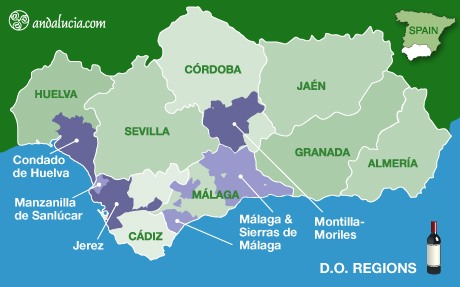This month, the World Wine Travel (#WorldWineTravel) group of writers continues its virtual tour of Spain with a with a visit to Andalusia in southern Spain. For more information about Andalusia see my invitation post here.
Andalusia Wine
Spanish viticulture originated in what is now known as Andalusia around 1100 BC when Phoenicians founded a trading post in Andalusian province of Cadiz. The Phoenicians were followed by the Carthaginians, who were followed by the Romans (It was the Romans who expanded viticulture north to regions like Rioja) The Romans widely exported and traded Spanish wine throughout their empire. The two largest wine producing regions under the Romans were Tarragona (in Catalonia region) in the north, and Andalusia in the south.
After the fall of the Roman empire, Iberia was long under the control of the Moors and Islam, and winemaking was discouraged if not outright forbidden here from 711 to 1492, when King Ferdinand II of Aragon and Queen Isabella I of Castille conquered the Nasrid Kingdom of Granada, finally freeing Spain from Muslim rule after nearly 800 years
In the 17th and 18th centuries the wines of Rioja and sweet fortified wines from Sherry and Malaga flourished for a time, but generally Spain lagged behind other European countries.
The Jerez-Xeres-Sherry wine region located in Cadiz is undoubtedly, the star in Andalusian wines. The region goes by three names because it wines are popular in Spain as Vinos de Jerez, but also in France as Xerez and England as Sherry. Jerez is one of the oldest wines in the world, and today’s product is a consequence of the influence of many civilizations: Phoenicians, Greeks, Romans, Moors, Spanish and British, who all contributed to create the well known and loved drink.
Malaga and Sierras de Malaga, which occupy the same area but are separate DOs east of Jerez, produce sweet wines and dry table wines respectively.
List of Andalusia DOPs (Source)
Andalusia has seven geographically classified Denominación de Origen Protegida (D.O.P.) that are regulated for quality according to specific laws, and in compliance with European Commission Regulation.
- Condado de Huelva DO
- Granada DO
- Jerez-Xerez-Sherry DO
- Málaga and Sierras de Málaga
- Manzanilla-Sanlúcar de Barrameda
- Montilla-Moriles DO

Here’s What We Have Planned:
Join our group on Oct. 23, 2021 for our exploration of the Wines of Andalusia. Here’s a list of posts you can expect. Then, join our Twitter chat all about Wines of Andalusia on October 23 at 8am PT/11am ET. Just search for the #WorldWineTravel hashtag on Twitter.
- Camilla of Culinary Adventures with Camilla offers Tapas on Toast: Spanish Montaditos + 2017 Sierras de Málaga Laderas de Sedella Anfora.
- Lynn of Savor the Harvest reveals Three Facts About Sherry and Why You Need to Try a Bottle.
- Terri of Our Good Life gives us A Beginner’s Guide to Amontillado and Spanish Tapas.
- Wendy of A Day in the Life on the Farm brings us A Friday Night Cocktail that starts with Alvear Tres Miradas Vino de Pueblo 2018.
- Susannah of Avvinare is Learning to Love Sherry One Style at a Time.
- Reggie at Wine Casual offers Tips for Sherry Lovers Visiting Sevilla and Jerez de la Frontera.
- Jeff Burrows of Food Wine Click! asks Sherry is a Fortified Wine, or is It?
- Nicole of Somm’s Table dishes Bodegas Dios Baco PX and a Banana Cake.
- Gwendolyn of Wine Predator…Gwendolyn Alley declares Oh My Corazón: Spanish Songs, Soup, Stew, and Sherry in Andalucía.
- Martin of ENOFYLZ Wine Blog serves up 2018 Jorge Ordoñez & Co. Moscatel Old Vines Botani + Trout Tartine with Stone Fruit.
`Related Posts:
An Exploration of Sherry; In the Glass And At The Table (for background on Sherry and pairings of the five dry style Sherry, and a sweet Sherry).